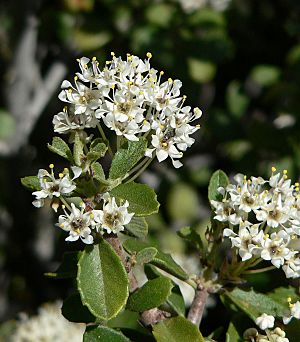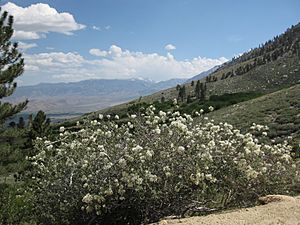Mojave ceanothus facts for kids
Quick facts for kids Mojave ceanothus |
|
|---|---|
 |
|
| Scientific classification | |
| Kingdom: | |
| (unranked): | |
| (unranked): | |
| (unranked): | |
| Order: | |
| Family: | |
| Genus: |
Ceanothus
|
| Species: |
C. greggii
|
| Binomial name | |
| Ceanothus greggii |
|
Ceanothus greggii, also known as the desert ceanothus, is a type of flowering shrub. It belongs to the buckthorn plant family, called Rhamnaceae.
You can find this plant naturally in the Southwestern United States (like Arizona, California, New Mexico, Texas, and Utah) and northern Mexico. It loves dry places such as desert areas, sagebrush fields, and chaparral lands. It grows on mountain slopes, usually between about 1,000 to 2,300 meters (3,300 to 7,500 feet) above sea level.
A scientist named Asa Gray from Harvard University gave the plant its name in 1853. He named it after Josiah Gregg, who first found the plant in 1847. Josiah Gregg discovered it in Coahuila, Mexico, during the Mexican–American War.
Contents
What Does It Look Like?
The desert ceanothus is a shrub with many branches. It grows straight up and can reach almost 2 meters (about 6.5 feet) tall. Its woody stems are gray and feel a bit fuzzy. The branches grow in pairs, one across from the other, and are quite stiff.
This plant has evergreen leaves, meaning they stay green all year. The leaves are small, about 2 to 9 millimeters long. They also grow in pairs. Their shape can be different, but they all have a clear line down the middle. The edges of the leaves might be smooth or have small teeth. Often, the leaves are slightly cupped, like a tiny bowl.
Flowers and Fruit
The desert ceanothus produces small groups of many white flowers. These clusters are less than 2 centimeters (0.8 inches) long. The flowers grow on short side branches and bloom in the spring. They are known for having a very pleasant smell.
After the flowers, a horned fruit grows. It is a small capsule, only a few millimeters wide. When the fruit is ready, it bursts open with a pop! This explosion shoots out the three seeds inside. These seeds need to be heated by a wildfire before they can sprout and grow into new plants. This process is called thermal scarification.
Animal Interactions
Many animals enjoy eating the desert ceanothus. Livestock like cows and goats, as well as wild animals such as mule deer and desert bighorn sheep, often browse on its leaves and branches.
Different Types of Desert Ceanothus
There are a few distinct types, or varieties, of Ceanothus greggii:
- Ceanothus greggii var. franklinii – This type is found only in Grand and San Juan counties in Utah.
- Ceanothus greggii var. greggii – This is the most common type of desert ceanothus.
- Ceanothus greggii var. perplexans – Also known as Gregg's ceanothus.
- Ceanothus greggii var. vestitus – This type is called Mojave ceanothus.


